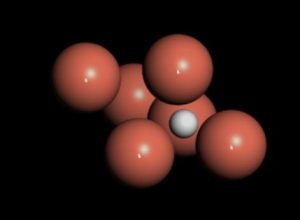This project aims to find zero point vibrational energy (ZPVE) for H atom adsorbed at Cu(111) hollow site through calculating Hessian matrix, which was built through second order finite difference approximation.
H adsorption optimization
The geometry optimization was performed in Material Studio with CASTEP Calculation Package [1]. The functional of Perdew Burke, and Ernzerhoff was employed [2]. Cu bulk was first optimized with medium SCF tolerance. Energy cutoff of 480 eV and 9 X 9 X 9 K points sampling were used. The pseudopotential was solved through Koelling-Harmon treatment. After Cu optimization, 111 surface was cut from bulk and H atom was place at hollow hcp site. K points of 11 X 11 X 1 was applied for slab optimization. Figure 1 shows optimized configuration, in which four layers of Cu was chosen and 20 angstrom vacuum was built above the surface to ensure no interaction between super cells.

Figure 1. Optimized H adsorption at Cu (111) hollow hcp site

Figure 2. Optimized H adsorption at Cu (111) hollow fcc site
Energy of structure with 0.05 angstrom H displacement at hcp site
| deltax | deltay | deltaz | E(eV) |
|---|---|---|---|
| 0 | 0 | 0 | -5057.904815339 |
| -0.05 | 0 | 0 | -5057.900058684 |
| 0.05 | 0 | 0 | -5057.900254389 |
| 0 | -0.05 | 0 | -5057.899918579 |
| 0 | 0.05 | 0 | -5057.900491436 |
| 0 | 0 | -0.05 | -5057.902027622 |
| 0 | 0 | 0.05 | -5057.897504906 |
| 0.05 | 0.05 | 0 | -5057.895183611 |
| 0.05 | -0.05 | 0 | -5057.894736028 |
| -0.05 | 0.05 | 0 | -5057.896567514 |
| -0.05 | -0.05 | 0 | -5057.895964697 |
| 0.05 | 0 | 0.05 | -5057.893632073 |
| 0.05 | 0 | -0.05 | -5057.896676147 |
| -0.05 | 0 | 0.05 | -5057.893493162 |
| -0.05 | 0 | -0.05 | -5057.896416514 |
| 0 | 0.05 | 0.05 | -5057.893875845 |
| 0 | 0.05 | -0.05 | -5057.896914666 |
| 0 | -0.05 | 0.05 | -5057.893352868 |
| 0 | -0.05 | -0.05 | -5057.896277175 |
Energy of structure with 0.05 angstrom H displacement at fcc site
| deltax | deltay | deltaz | E(eV) |
|---|---|---|---|
| 0 | 0 | 0 | -5057.908254387 |
| -0.05 | 0 | 0 | -5057.903846876 |
| 0.05 | 0 | 0 | -5057.902812323 |
| 0 | -0.05 | 0 | -5057.905355245 |
| 0 | 0.05 | 0 | -5057.901336034 |
| 0 | 0 | -0.05 | -5057.903434736 |
| 0 | 0 | 0.05 | -5057.900649874 |
| 0.05 | 0.05 | 0 | -5057.896923968 |
| 0.05 | -0.05 | 0 | -5057.900397672 |
| -0.05 | 0.05 | 0 | -5057.895898678 |
| -0.05 | -0.05 | 0 | -5057.900587944 |
| 0.05 | 0 | 0.05 | -5057.896058663 |
| 0.05 | 0 | -0.05 | -5057.897022898 |
| -0.05 | 0 | 0.05 | -5057.896937081 |
| -0.05 | 0 | -0.05 | -5057.898270256 |
| 0 | 0.05 | 0.05 | -5057.894816130 |
| 0 | 0.05 | -0.05 | -5057.895334570 |
| 0 | -0.05 | 0.05 | -5057.898164719 |
| 0 | -0.05 | -0.05 | -5057.900003390 |
Then finite difference approximation was used to calculate Hessian matrix elements. The diagonal element can be obtained as equation (1) and off-diagonal element can be obtained from equation (2).
\begin{equation} H_{ii} \cong \frac{E(\delta x_{i})+E(-\delta x_{i})-2E_{0}}{\delta x_{i}^2} \end{equation}
\begin{equation} H_{ij} \cong \frac{E(\delta x_{i}, \delta x_{j})+E(-\delta x_{i},-\delta x_{j})-E(\delta x_{i}, -\delta x_{j})-E(-\delta x_{i}, \delta x_{j})}{4\delta x_{i}\delta x_{j}} \end{equation}
After calculating eigenvalues of Hessian matrix, we can calculate vibrational frequency and corresponding zero point energies, which is shown in following table.
| site | Zero point energy (eV) |
|---|---|
| hcp | 0.1893 |
| fcc | 0.2001 |
Conclusions
In this project, we applied harmonic approximation and use finite difference approximation to calculate vibrational frequency of H atom adsorbed at the Cu(111) hollow sites and further zero point energy. According to our calculation, the zero point energy of H on hcp site is 0.1893 eV and H on fcc site is 0.2001 eV. The difference of the zero point energies between H on fcc site and hcp site are less 0.011 eV.
Reference
[1] “First principle methods using CASTEP” Zeitschrift fuer Kristallographie 220(5-6) pp. 567-570 (2005)
[2] Perdew, J. P; Burke, K; Ernzerhof, M. Phys. Rev. Lett. 1996, 77, 3865-3868

